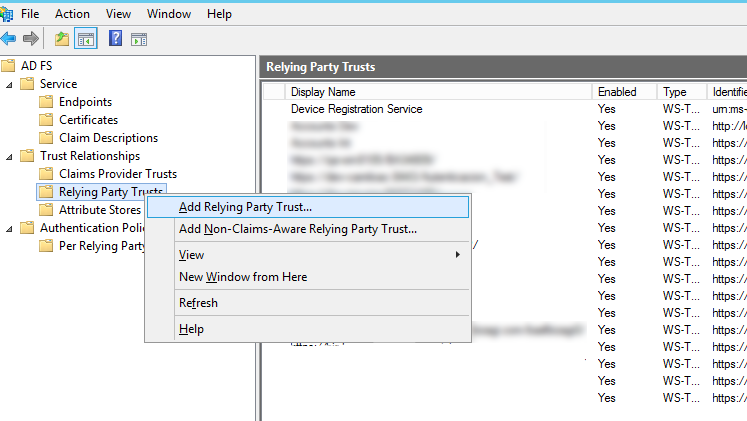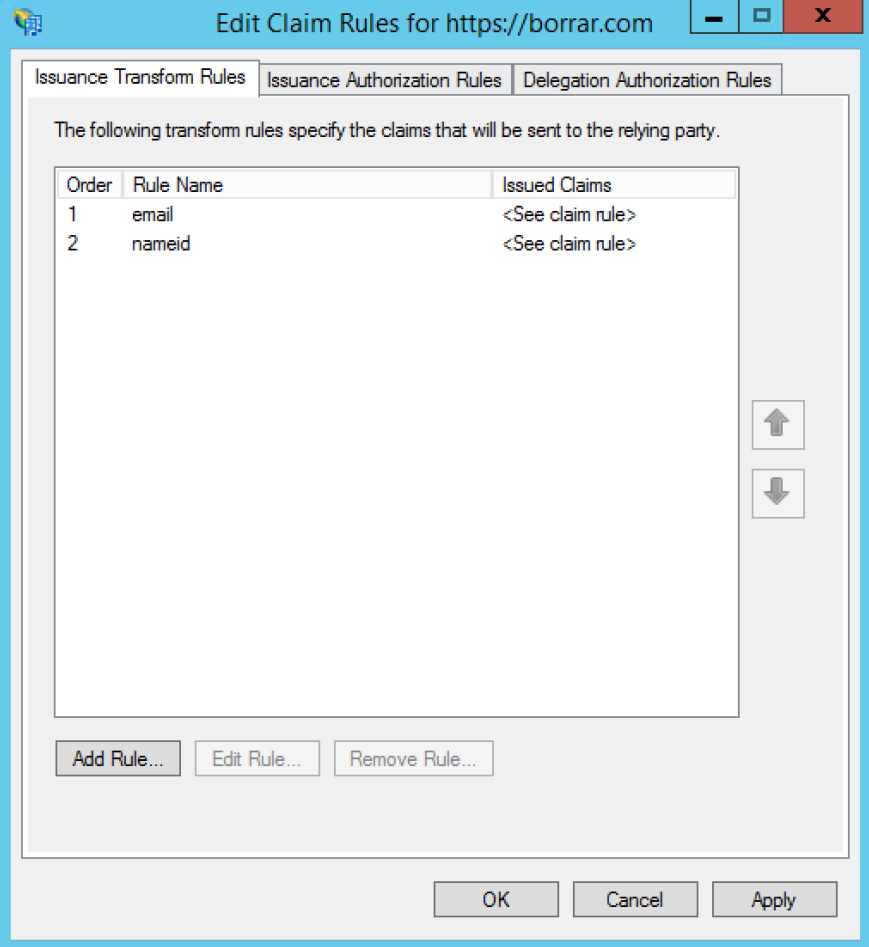Overview
Bizagi supports integration with Identity and Access Management systems (i.e, Identity Managers or Identity Providers) which are SAML 2.0 compliant, such as Microsoft ADFS.
This section is a step-by-step guide to configuring in ADFS and in Bizagi to have an integrated authentication in Bizagi against ADFS.

For SAML 2.0, both your Identity Provider and your Bizagi project must be set up to support HTTPS.
For introductory information about SAML 2.0, refer to Authentication via SAML.
|
If you plan on using an authentication method different than Bizagi and you are performing a deployment to an environment with no users on it (normally this would only be the case for a project's first deployment), follow these steps so that you can correctly configure your users and authentication without getting locked out of the Work Portal: 1.Perform the deployment with the authentication method set to Bizagi. This lets you access the Work Portal as the Admon user without providing any credentials. 2.Once in the Work Portal you can manually enter your users, or alternatively you can rely on the method of your choice to synchronize your users' information into the WFUser table (SOAP, Excel file, LDAP Synchronization, or performing a Data Synchronization procedure). 3.After having your users registered in the Work Portal, use the Management Console to set the authentication method to your preferred one.
If you plan on using LDAP authentication with periodic users synchronization, you may ignore the previous steps since you will only need to wait until the next synchronization happens for your users to be able to log into the Work Portal. |
1. Generate certificates to sign assertions (mandatory)
The following explains how to generate the security certificate from the Customer Portal:
|
You will need to be in charge of managing your installed certificates (keep track of its expiration date and other relevant maintenance aspects such as changes in your Identity Provider's endpoints). |
Create Authentication Certificates
You can generate security certificates for the Authentication Protocols within the Customer Portal. This feature allows you to create and configure a new certificate or upload an existing one in the Customer Portal. To setup the Single Sing On and access the Customer Portal, sign on to your account role as a Company Administrator. This user role can this user can create users in the company user's pool, and manage users in all the company subscriptions. For additional information about Managing Customer Portal and roles refer to:
To create a security certificate inside the Customer Portal follow these steps:
1.Select the Settings icon located in the left panel menu.
![]()
2.A panel expands from the left with all the security related topics. Select the Authentication certificates option.

3.Inside this section, there is a list of certificates with details like Name, Description, Expiration date, Owner and Creation date and its creation source. In the top right corner, select the Add certificate button.

4.The Add new authentication certificate window opens for you to create the new security certificate and you must fill out the five different required fields:
a.Display Name.
b.Description.
c.Either select the Generate (to create a new certificate) or Upload (to upload a existing certificate) option for the toggle button.
d.Expiration date.
e.Certificate password.
When you select the Generate option, set the Expiration date and assign a Certificate password. If you select the Upload option, you are required to upload digital certificates files in a PFX or a P12 format and then, select the type of algorithm to implement between SHA256 and SHA1. For last, enter the password from the certificate.

5.After all the required fields have been entered, click Save in the top right corner.

After the certificate is created a message will appear in the right bottom corner indicating it has successfully been saved.

To manage the generated security certificate in the Customer Portal refer to the Managing Authentication Certificates documentation.
2. Configure your IdP in Bizagi
After you configure the application in Entra ID, now you must access the Bizagi Studio or the Management Console and register the Identity Provider. Follow the steps in Configure a SAML 2.0 IdP in Bizagi.
3. Download the Bizagi metadata file
After you configure the identity provider in Bizagi, you must generate the metadata file. Refer to Download the metadata file.
4. Configure Bizagi as Service Provider in ADFS
Do this in the admin options in ADFS.
4.1. In your ADFS server, open the administration console.
4.2. Launch the creation of a relying party trust.
Right-click Relying party trust to display the options menu, and select the configuration wizard:

Click Start.

4.3. Select the data source.
To configure the relying party, select the Import data about the relying party from a file option and browse for the metadata file generated by Bizagi.

4.4. Select the metadata file.
Make sure you locate Bizagi's metadata.xml file.

Click Next when done.
4.5. Enter a unique name.
Give a display name to this configuration, for your convenience.

Click Next when done.
4.6. Skip multi-factor authentication.
Select the I do not want to configure multi-factor authentication settings for this relying party trust at this time option and click Next.

4.7. Choose issuance authorization.
Select the Permit all users to access this relying party option and click Next.

You see a summary of the information to set for this relying party trust, including the information that came from Bizagi's metadata file.
You may click Next when done.
You may also check (in the Advanced view) that the algorithm set for this use (either SHA1 or SHA256), matches the one configured in Bizagi.
4.8. Open the Claim rules editor.
Before you close the actual configuration window, check the Open the Edit Claim Rules dialog for this relying party trust when the wizard closes checkbox.

Then click Close.
4.9. Define a new claim rule by clicking Add Rule.

4.10. Select the Send Claim Using a Custom Rule template.

Click Next when done.
4.11 Create the following rules:
Rule 1
•Rule name: email
•Custom rule: c:[Type == "http://schemas.microsoft.com/ws/2008/06/identity/claims/windowsaccountname", Issuer == "AD AUTHORITY"] => issue(store = "Active Directory", types = ("http://schemas.xmlsoap.org/ws/2005/05/identity/claims/emailaddress"), query = ";mail;{0}", param = c.Value);

Rule 2
•Rule name: nameid
•Custom rule: c:[Type == "http://schemas.xmlsoap.org/ws/2005/05/identity/claims/emailaddress"] => issue(Type = "http://schemas.xmlsoap.org/ws/2005/05/identity/claims/nameidentifier", Issuer = c.Issuer, OriginalIssuer = c.OriginalIssuer, Value = c.Value, ValueType = c.ValueType, Properties["http://schemas.xmlsoap.org/ws/2005/05/identity/claimproperties/format"] = "urn:oasis:names:tc:SAML:1.1:nameid-format:emailAddress");

When you are done, your newly created rules are displayed as shown in the image below.

The rule may not be recognized right away. If so, delete the rule, create it once again and restart the ADFS server.
At this point you have configured your ADFS to rely on SAML 2.0 for an integrated authentication with Bizagi!
You will need to carry out the next part only if you have employed self-signed certificates.
Additional step for self-signed certificates
If you have issued and installed a self-signed certificate for your ADFS for signing and encrypting purposes, you will need to perform the following:
1.Access your ADFS server and open a PowerShell console.
2.Enter the following command:
Get-AdfsRelyingPartyTrust -Identifier [relying_party_trust] | Set-AdfsRelyingPartyTrust
-SigningCertificateRevocationCheck None -EncryptionCertificateRevocationCheck None
Replace [relying_party_trust] accordingly to the unique name given at the configuration above (when you register Bizagi's relying party trust).
Now when you run the Work Portal, Bizagi displays the IdP log-in page and users can be authenticated with your Identity Provider.
|
Remember to do this configuration in all your environments, or to deploy security configurations in your target environments, for example, test or production environments. |
Last Updated 9/11/2024 10:24:54 AM